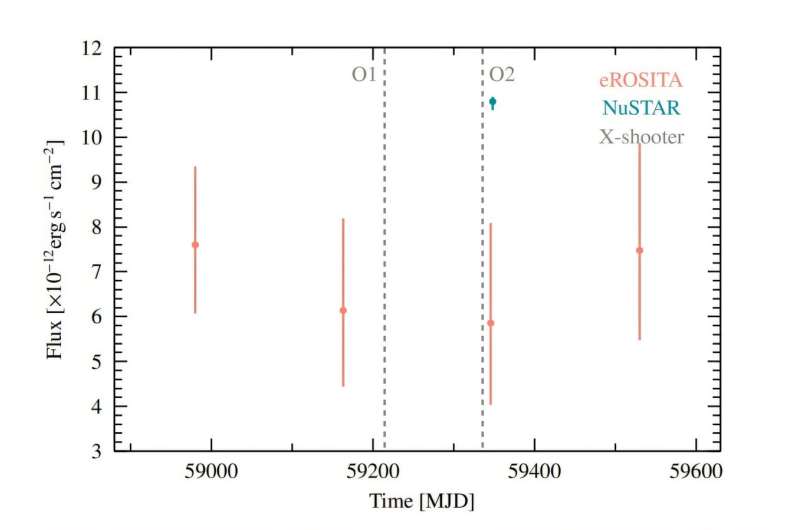
An international team of astronomers has conducted a multiwavelength study of an X-ray binary designated 1eRASS J085039.9-421151. Results of the study, published Nov. 4 on the preprint server arXiv, yield new information regarding the nature and properties of this system.
X-ray binaries (XRBs) are composed of a normal star or a white dwarf transferring mass onto a compact neutron star or a black hole. Based on the mass of the companion star, astronomers divide them into low-mass X-ray binaries (LMXBs) and high-mass X-ray binaries (HMXBs).
1eRASS J085039.9-421151, or J085039 for short, was initially identified as an X-ray source in the first eROSITA All-Sky Survey (eRASS1). Further observations of J085039 have suggested that it is an X-ray binary due to its positional coincidence with the star UCAC2 13726137, which is only approximately three arcseconds away from the source, and has since been identified as a K-type supergiant. The distance to the system is estimated to be 24,300 light years.
Now, a group of astronomers led by Aafia Zainab of the University of Erlangen–Nuremberg in Germany has taken a closer look at J085039 in order to explore its true nature. For this purpose, they analyzed the data from the extended ROentgen Survey Imaging Telescope Array (eROSITA) onboard the Spektr-RG spacecraft, the Nuclear Spectroscopic Telescope Array (NuSTAR), and the X-shooter instrument on the Very Large Telescope (VLT).
“Here, we report on the analysis of the eROSITA data, a pointed observation with NuSTAR, and archival observations from the ESO Very Large Telescope (VLT)’s spectrograph X-shooter of the optical counterpart, with the primary focus on determining the nature of its compact object,” the researchers wrote.
The observations found that J085039 is a HMXB consisting of a neutron star and a red supergiant companion of spectral type M2-3. This makes it only the second known galactic X-ray binary with a red supergiant.
According to the paper, J085039 has an X-ray luminosity at a level of 300 decillion erg/s and a mass accretion rate onto the neutron star of about 1.72 trillion kg/s. The lightcurve of J085039 displays consistently low flux for the entire observational time of 13 years.
The observations detected a strong fluorescent neutral iron line in the spectra of J085039. This finding suggests an obscuration of the X-ray source by the wind of the supergiant companion or other circumstellar material.
The authors of the paper noted that no outbursts nor any pulsations of J085039 have been detected as part of their study. However, they do not exclude the possibility of the source’s variability beyond 200 seconds, which may be undetected due to insufficient counting statistics provided by the data at low frequencies.
More information:
Aafia Zainab et al, Multiwavelength study of 1eRASS J085039.9-421151 with eROSITA NuSTAR and X-shooter, arXiv (2024). DOI: 10.48550/arxiv.2411.02655
Journal information:
arXiv
© 2024 Science X Network
Astronomers inspect the nature of an X-ray binary with a red supergiant (2024, November 14)
retrieved 15 November 2024
from https://phys.org/news/2024-11-astronomers-nature-ray-binary-red.html
part may be reproduced without the written permission. The content is provided for information purposes only.